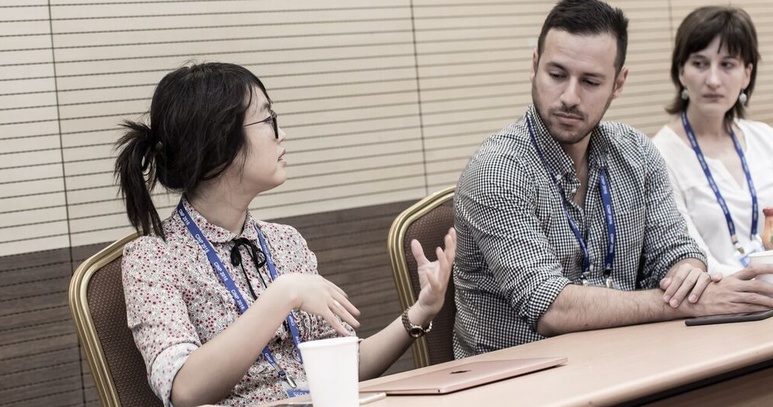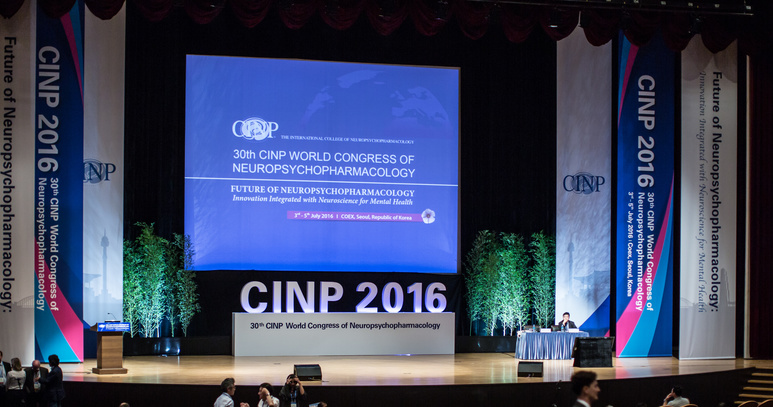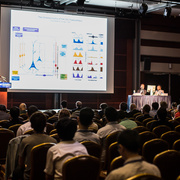
Choose a channel
Check out the different Progress in Mind content channels.

Progress in Mind




In a world of seemingly endless ways and means to keep abreast of the latest research, and countless virtual channels through which to forge networks and relationships, it seems the traditional congress is still very much alive.
At a closed workshop held during CINP 2016, a number of the recipients of the Young Investigator travel award* were brimming with ideas about ways to enhance the congress experience, yet were unanimous that the tried-and-tested elements of the congress concept still hold great appeal for young scientists and clinicians.
Attending talks by experts, networking with peers, hearing the latest research-thinking and taking time out from the rigors of their everyday research work and clinical practice – to reflect on the broader aspects of neuroscience and psychiatry – are enriching experiences. According to the young investigators at CINP, there is no substitute for face-to-face meetings and being part of the community engendered by a congress.
But that’s not to say that meeting and congress organizers should be complacent, or that there aren’t opportunities to make the congress experience better.
The Millennial app- and twitter-savvy generation want congress plans at their finger-tips, and sharing on social media is a given. Young investigators appreciate that congress data may be new and embargoed information, yet can see that high quality facts, opinions and concepts are worthy of wider dissemination. During the workshop, young investigators used the example of TEDx talks – ‘ideas worth spreading’ – which keep conversations going long after an event as an approach congresses could adopt, and during the congress, they would be more than happy to use and share handles and hashtags to communicate congress ideas and messages. They just want presenters to realise that when a delegate appears to be on their ‘phone – it probably means they are tweeting pearls of wisdom from the talk!
Young investigators appreciate that short of a major culture change, their older peers may not all rush to embrace twitter, but they suggested that facebook and facebook pages have broader generational appeal and they think that medical societies could work, for example, with student helpers willing to be their social media whizzes (officers) who establish and run social media campaigns.
During a congress, young investigators find plenary lectures by thought leaders and poster sessions to be excellent learning and idea-generating experiences. Soaking up ideas and being able to meet and talk with other scientists and clinicians is something the CINP young investigators think should be a regular event in their calendars. While not averse to e-learning opportunities and catching up on missed congress events via post-congress webcasts, the up-coming generation would prefer a concentrated dose of real-time interaction with their colleagues.
* Jee Hyun Kim, Australia; Jiamei Lian, Australia; Daniel Quintana, Australia; Saddichha Sahoo, Australia; Giulia Treccani, Italy (currently working in Denmark)
Young investigators, attending CINP 2016 through the Rafaelsen travel award scheme, shared their thoughts on what they like about coming to meetings.

Management and study of depression – with its strong focus on affect, mood and emotion – has for a long time underplayed the importance of cognitive dysfunction as a core feature of depression. At a 2016 CINP scientific session, the need for discovery, development and translation in the domain of cognitive dysfunction in depression was stressed by co-chair and presenter Professor Barbara Sahakian, Professor of Clinical Neuropsychology at the Department of Psychiatry, University of Cambridge, UK.
Professor Sahakian reminded delegates that cognitive deficits often persist in remitted patients, impacting on their ability to return to work, education and normal function. She spoke of the importance of better and earlier detection and treatment of depression and the fact that untreated or undertreated depression leads to poorer response rates, more relapse and greater disease chronicity.
Cognitive deficits and dysfunction, she said, contribute greatly to the financial losses associated with depression, where both absenteeism and presenteeism contribute to loss of productivity. Professor Sahakian spoke about the importance of considering both mental well-being and mental capital – where a person’s ‘mental capital’ encompasses their cognitive and emotional resources and resilience in the face of stress. The term ‘capital’ rightly associated with ideas of financial capital as well as the ‘capital’ of the mind.
Professor Sahakian said that cognitive dysfunction is not simply a residual domain in depression but a core aspect of depression and possibly an early biomarker for depression. She said researchers in Cambridge are looking for cognitive biomarkers for in adolescents – for example looking at oversensitivity to negative feedback and negative attentional bias as potential predictors for the later development of depression.
Professor Sahakian asked the audience how familiar they were with the concepts of hot and cold cognition, explaining that cold cognition is the term used to describe broadly non-emotional cognitive functions, while hot cognition includes emotional, often time-limited cognitive functions where there may be a conflict between risk and reward. Hot cognition includes negative attentional bias and responses to negative feedback.
Depression affects both hot and cold cognition and Professor Sahakian reminded delegates again that cognitive dysfunction in depression is the biggest barrier to rehabilitation. Forgetfulness, difficulty focussing – cold cognitive impairments, and sensitivity to negative feedback – hot cognitive impairments, are features of cognitive dysfunction that can make return to work or education very difficult. Professor Sahakian said that cognitive deficits in remitted depression are also associated with higher depression relapse rates.
Other speakers in the session reported on clinical studies looking at the impact of antidepressant agents on cognitive dysfunction in depression and remitted depression, and described some of the challenges and new methods and ideas that will be needed for continued drug discovery and exploration of this domain of depression.
Cognitive dysfunction is a core feature of depression that often persists in ‘remitted’ patients.



Artificial intelligence is a term that conjures up images of robots and machines capable of intelligent thought. In the field of psychiatry, artificial intelligence principles and practices are being used to take neuroimaging data and develop biomarkers that could support a clinical diagnosis and quantify and describe that diagnosis.
Dr Mitsuo Kawato of the ATR Computational Neuroscience Laboratories in Kyoto, Japan, has been involved in research that for the first time defines the biological dimension – an imaging dimension – of a psychiatric diagnosis. Research published by Dr Kawato and colleagues in Nature Communications in 2016 ranked among the top 1% of viewed scientific papers published in same period. Dr Kawato believes this is because the paper dealt with an artificial intelligence application that could define autism spectrum disorder (ASD) using neuroimaging-based classifiers – or biomarkers. The research team are using the application to define and create neuroimaging biomarkers for major depressive disorder (MDD), schizophrenia, obsessive compulsive disorder (OCD) and chronic pain syndromes.
Taking data from 200 patient samples, and looking at 10,000 neuroimaged connections and 140 brain lesions, Dr Kawato said it had been possible, using sophisticated artificial intelligence algorithms, to select the 16 functional connections that are specific for and discriminate ASD from normal (typically developed) brains. He explained that this type of computational neuroscience allows the description of one scale – one dimension – that plots the Gaussian distribution for typically developed individuals and another that plots the distribution for, in this case, ASD. This biomarker tool therefore also allows for a quantitative assessment – or score for the diagnosis.
What is more, Dr Kawato explained that these neuroimaging biomarkers being developed not only define and describe a specific diagnosis, but highlight distinctions between diagnoses and similarities and closeness of certain diagnoses. For example he said that the ASD neuroimaging biomarker could not distinguish MDD patients from their controls, but showed some ability to discriminate between patients with schizophrenia and controls. According to Dr Kawato, this closeness between ASD and schizophrenia is in keeping with historical views that these conditions shared some commonality and with genetic studies indicating common loci for schizophrenia and ASD.
Dr Kawato believes that neuroimaging biomarkers will be a valuable support to clinical diagnosis and will become a reality of practice and diagnosis in the near future. He told Progress in Mind: “In other disciplines of medicine like cardiovascular medicine and oncology for example, it is common to examine biomarkers – be they blood biomarkers or imaging scans (fMRI and PET). But in psychiatry, we haven’t had that kind of quantitative measurement to support the clinical diagnosis.”
“We had two objectives. The first was to provide objective scales to support clinical diagnosis with neuroimaginging based biomarkers.” Dr Kawato then said that if these biomarkers prove to be really reliable, it may be possible to use these tools to explore and describe the neurocircuits and brain regions with correlates for predicting certain diagnosis.
Dr Kawato described how the neuroimaging biomarker looks at resting state fMRI, with a 5-10 minute scan providing the data to allow a quantitative diagnosis. He said that in the future it might be possible, not just to diagnose one condition, but to use all the available biomarker scales to see if, in the case of ASD for example, a person has a condition more predominantly located between ASD and schizophrenia – or located closer to the normal healthy position.
These developments in neuroimaging biomarker research might also have applications in the management of psychiatric disorders. Dr Kawato said that real-time feedback based on imaging biomarkers might have therapeutic applications in some diagnoses. He explained: “We can define “ASDness” and then in realtime we can feed this back to our patient as a score. It’s something a bit like cognitive behavioural therapy or psychotherapy, although a little bit more high tech.” Dr Kawato said that pilot studies in ASD, MDD and chronic pain conditions, have been looking at this real-time feedback. According to Dr Kawato, outcomes may depend on the learning capability of a given patient and some conditions may be more amenable to reinforcement conditioning than others.
For the future, Dr Kawato said that neuroimaging biomarkers may soon become a clinical reality and he hoped that machine learning algorithms based on biomarkers might also find a place as another modality in the management of psychiatric disorders.
Computational neuropsychiatry is a new discipline, exciting huge interest for its potential in diagnosis and possibly even management.




Psychiatry is evolving as a profession. The number of patients with mental disorders in all life-cycle phases, from childhood to old age, is increasing all over the world and is responsible for enormous social and economic loss. The expectations for psychiatry as a profession are getting higher.
However, such complex and heterogeneous psychiatric disorders still cannot be classified and diagnosed precisely by diagnostic criteria such as DSM and ICD. Professor Yamawaki encourages us to establish objective diagnosis by utilizing findings of recent brain science research, and develop innovative treatments. If not, the expectation towards psychiatry may turn into disappointment.
The field of psychiatry is developing in a number of areas. Development of contemporary cognitive, affective and social neuroscience using neuroimaging are especially prominent. Molecular target data are being accumulated using genome and epigenome research and proteomics; however, issues such as reproducibility have arisen. In order to elucidate the pathophysiology of complex psychiatric disorders with variant, heterogeneous conditions, and to establish objective diagnosis, we need large cohort studies which have incorporated brain function and biomarker measurements, as well as clinical evaluation.
While there are many hurdles to achieving breakthroughs in our field, the theme of the 30th CINP congress is one to strive for - Innovation Integrated with Neuroscience for Mental Health.
The CINP have made active efforts to accelerate the development of biomarker and objective diagnosis by precompetitive collaboration of public and private institutions - a collaboration of basic and clinical academia, pharmaceutical companies and regulatory agencies.
By applying every brain science approach such as genomics, proteomics and neuroimaging and data analysis techniques, he is confident that we will see breakthroughs in the future.
The full video interview with Professor Yamawaki will be posted on www.progress.im soon. Also, look out for our interview with Professor John Krystal, CINP President Elect, in which we hear about future plans for the CINP as he takes the position of CINP president
Sign up for our newsletter and we will keep you posted.
At the 30th international CINP congress in Seoul, Korea, we were privileged to speak with Professor Shigeto Yamawaki, President of the CINP, about changes and developments in the field and the valu